traction control JAGUAR XJ6 1994 2.G Electrical Diagnostic Manual
[x] Cancel search | Manufacturer: JAGUAR, Model Year: 1994, Model line: XJ6, Model: JAGUAR XJ6 1994 2.GPages: 327, PDF Size: 13.73 MB
Page 160 of 327

15.2.5 SECONDARY WARNING LAMPS - ILLUMINATED AMBER
15.2.5.1 Transmission Fault
The transmission fault indicator is controlled by a signal from the Transmission Control Module (TCM). The signal to
the instrument pack (pin 44,48-way connector) is switched high when a transmission fault occurs, and the indicator
lamp is illuminated.
15.2.5.2 Washer Fluid Level
The washer fluid level sensor, mounted in the fluid reservoir, provides a signal (pin 13, 48-way connector) when the
amount of fluid drops below a predetermined level. The switch is normally in the closed position, providing a low sig-
nal to the instrument pack, when the fluid level is acceptable. If the fluid level drops, the switch will open, removing
the low signal and illuminating the indicator lamp.
15.2.5.3 Bulb Fail
Bulb failure indication is controlled from two different sources:
If a direction indicator lamp fails, a signal is sent to the instrument pack (pin 18,48-way connector) from the Body. :o- cessor Unit (BPU). The signal is normally low but switched high if a bulb failure occurs; thuscausing the bulbfail indica-
If any of the other bulbs, monitored by the three lamp control modules, fail, a signal is sent direct to the instrument
pack (pin 43, 48-way connector). The signal is normally low but switched high if a bulb failure occurs; thus causing
the bulb failure indicator lamp to illuminate.
tor lamp to illuminate.
15.2.5.4 Traction Control Fail
Two traction control lamps are provided: control fail and control off. Both lamps are controlled from one input from
the ABS / TC Control Module.
Under normal operating conditions, the input signal should be high.
If the input line is continuously low, traction con- trol has failed and both lamps will illuminate. If the input signal is a 4 Hz square wave the traction control system is
switched off, therefore the ‘traction off lamp will illuminate.
15.2.5.5 Anti-lock Fail
The input to the instrument pack (pin 7,24-way connector) is provided by the ABS Control Module. The warning lamp
illuminates if the signal voltage is less than 5.0 volts or greater than 11.9 volts.
- 15.2.5.6 Low Fuel Level
This signal (pin 20,24-way connector) comes direct from the variable resistor type fuel level sensor. The sensor resis-
tance values range from 80 ohms (full tank) to 900 ohms (empty tank).
When the gauge reaches
a pre-determined reading, the instrument pack illuminates the warning lamp.
15.2.5.7 Check Engine
The ’checkeng’ indicator will illuminate when the Engine Control Module (ECM) detects a fault within the system, and
sends a signal to the instrument pack (pin 22,48-wayconnector). The signal line is pulled low by the ECM when a fault
is detected.
The indicator lamp will illuminate during each ignition cycle, until the engine fires.
X300 EDM 15.2-7 Issue 1 August 1994
Page 161 of 327
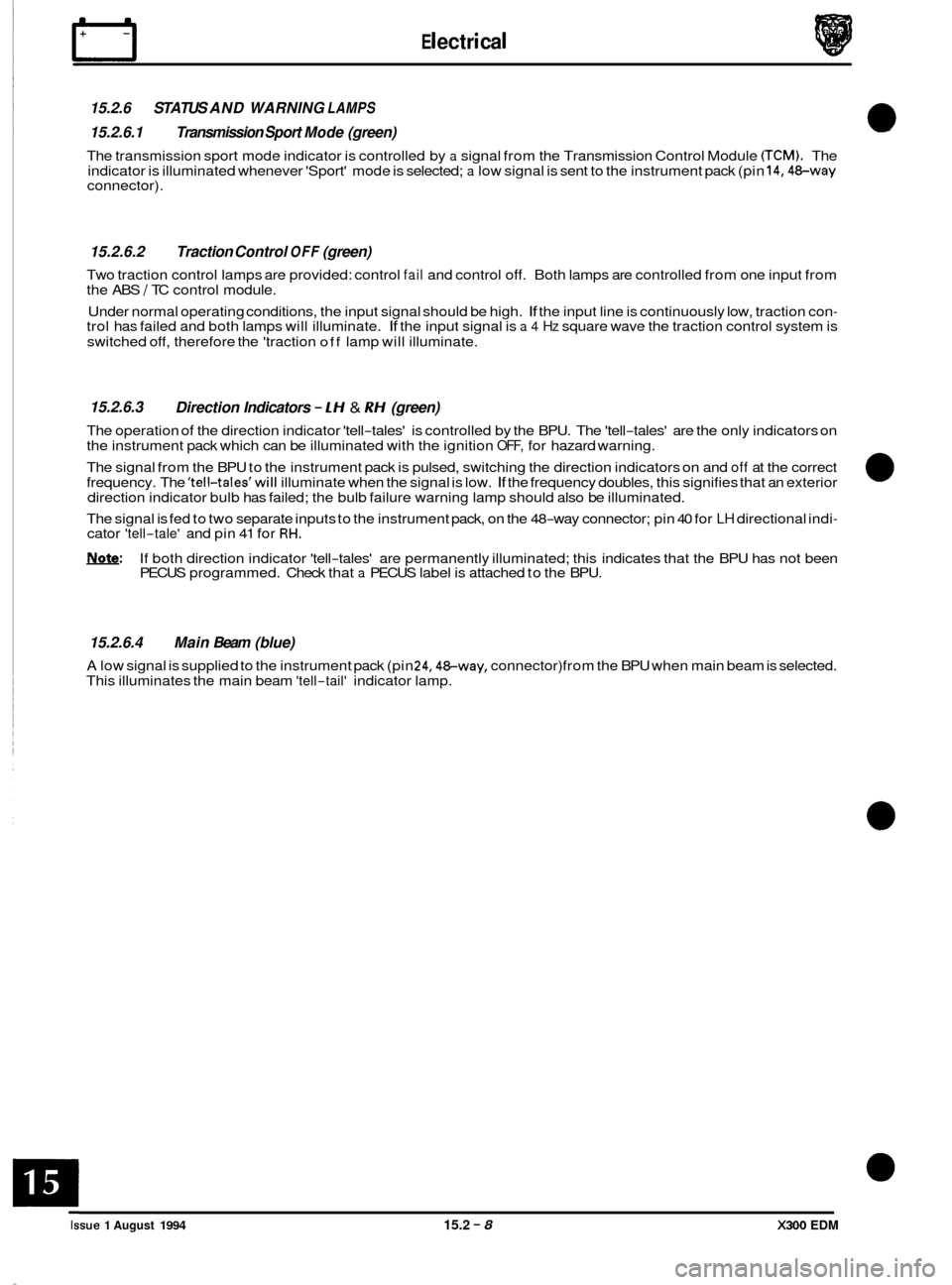
rl E I ect r i ca I
15.2.6 STATUS AND WARNING LAMPS
15.2.6.1 Transmission Sport Mode (green)
The transmission sport mode indicator is controlled by a signal from the Transmission Control Module (TCM). The
indicator is illuminated whenever 'Sport' mode is selected; a low signal is sent to the instrument pack (pin 14,48-way connector).
15.2.6.2 Traction Control OFF (green)
Two traction control lamps are provided: control fail and control off. Both lamps are controlled from one input from
the ABS I TC control module.
Under normal operating conditions, the input signal should be high.
If the input line is continuously low, traction con- trol has failed and both lamps will illuminate. If the input signal is a 4 Hz square wave the traction control system is
switched off, therefore the 'traction
off lamp will illuminate.
15.2.6.3
The operation of the direction indicator 'tell-tales' is controlled by the BPU. The 'tell-tales' are the only indicators on
the instrument pack which can be illuminated with the ignition OFF, for hazard warning.
The signal from the BPU to the instrument pack is pulsed, switching the direction indicators on and
off at the correct
frequency. The 'tell-tales'will illuminate when the signal is low. If the frequency doubles, this signifies that an exterior
direction indicator bulb has failed; the bulb failure warning lamp should also be illuminated.
The signal is fed to two separate inputs to the instrument pack, on the 48
-way connector; pin 40 for LH directional indi- cator 'tell-tale' and pin 41 for RH.
!We: If both direction indicator 'tell-tales' are permanently illuminated; this indicates that the BPU has not been
PECUS programmed. Check that a PECUS label is attached to the BPU.
Direction Indicators - LH & RH (green)
15.2.6.4 Main Beam (blue)
A low signal is supplied to the instrument pack (pin 24,48-way, connector) from the BPU when main beam is selected.
This illuminates the main beam 'tell-tail' indicator lamp.
Issue 1 August 1994 15.2 - 8 X300 EDM
Page 163 of 327

rl E I ect r ica I
15.2.8 INSTRUMENT PACK PIN-POINT TESTS
15.2.8.1 Oil Pressure, Battery Condition, Coolant Temperature and Fuel Gauges
Gauge reads zero, full scale, too high or low
1.
2.
3. Oil
pressure and coolant gauges only; check relevant fluid level is within limits, top up if required and re-check
indication. If fluid levels are within limits on checking proceed to step 2.
Check connections to sensor are correct and secure. For battery gauge only check battery voltage is present at the
battery terminal posts.
Check resistance of sensor (if applicable) to ground, correct readings are as detailed in the following table:
Sensor title Resistance value
Oil pressure 3108 - 3308
Temperature
Fuel level 3461
(warm engine)
- 2418 (cold engine)
8061 (full tank) - 9008 (empty tank)
If resistance is out of range renew sensor.
If sensor resistance is proved correct, check the harness wiring continuity between the sensor and instrument pack
pin as detailed in the table below:
4.
I Sensor title I Instrument pack pin !
I Oil pressure I 21 (24-way connector) I Temperature I 19 (24-way connector) I
Fuel level 120 (24-way connector)
For battery condition gauge, checkvoltage between instrument pack 24
-way connector pins 2 and 4 is 13 f 2.5V. Refer to Section 15.5 for battery diagnostics.
If all previous checks prove correct remove and open the instrument pack. Examine flexi-circuit connections to
relevant gauge, ensuring correct and secure fitment.
Check continuity of flexi
-circuit tracks to gauge connections.
Check continuity of gauge driver windings by disconnecting gauge from flexi
-circuit and testing between the
upper central connection pin and each of the other two pins. If open circuit is recorded renew gauge.
5.
6.
7.
Gauge fluctuates
or gives erratic readings
1. Carry out steps 1 -4 above.
2.
Fit new sensor (where applicable) and re-check gauge.
3. Carry out steps 5
- 7 above
15.2.8.2 Speedometer
Gauge reads zero, full scale, too high or low
1.
2.
3.
4.
5. Refer
to Section 12,
ABS / Traction Control for fault diagnosis of wheel speed sensor.
Check harness wirin and connection from Instrument pack pin 15 (24
-way connector) and ABS /Traction Control
Control Module (AB!! /TC CM).
If all previous checks prove correct remove and open the instrument pack. Examine flexi
-circuit connections to
speedometer, ensuring correct and secure fitment.
Check continuity of flexi
-circuit tracks to speedometer connections.
Check continuity of speedometer driver windings by disconnecting from flexi
-circuit and testing between the
upper central connection pin and each of the other two pins. If open circuit is recorded renew speedometer.
Page 178 of 327
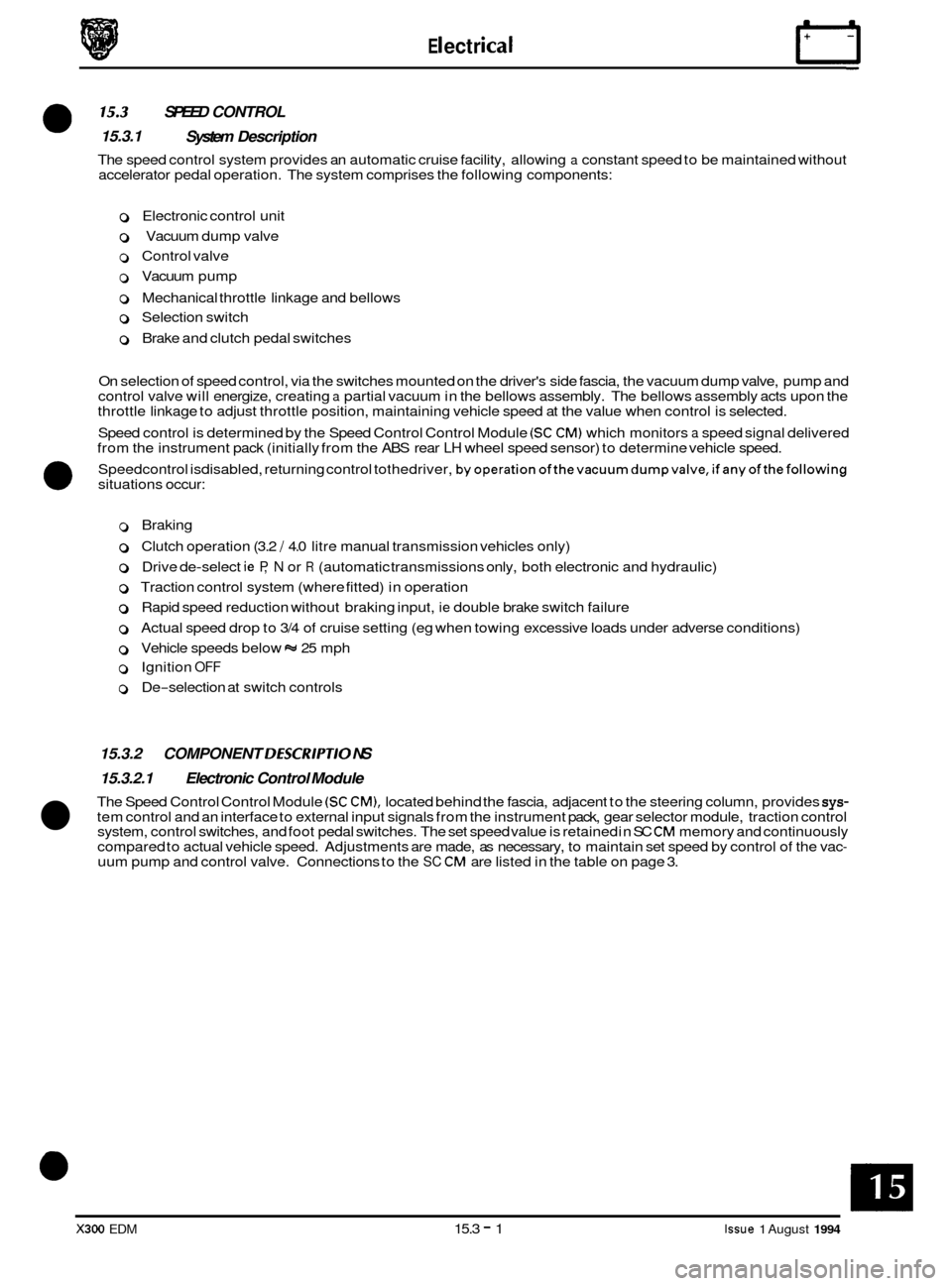
E I ect r ical IT
SPEED CONTROL
System Description
0 15.3 15.3.1
The speed control system provides an automatic cruise facility, allowing a constant speed to be maintained without
accelerator pedal operation. The system comprises the following components:
0 Electronic control unit
0 Vacuum dump valve
0 Control valve
0 Vacuum pump
0 Mechanical throttle linkage and bellows
0 Selection switch
0 Brake and clutch pedal switches
On selection of speed control, via the switches mounted on the driver's side fascia, the vacuum dump valve, pump and
control valve will energize, creating
a partial vacuum in the bellows assembly. The bellows assembly acts upon the
throttle linkage to adjust throttle position, maintaining vehicle speed at the value when control is selected.
Speed control is determined by the Speed Control Control Module
(SC CM) which monitors a speed signal delivered
from the instrument pack (initially from the ABS rear LH wheel speed sensor) to determine vehicle speed.
Speedcontrol isdisabled, returning control tothedriver,
byoperationofthevacuumdumpvalve,ifanyofthefollowing situations occur: 0
0 Braking
0 Clutch operation (3.2 / 4.0 litre manual transmission vehicles only)
o Drive de-select ie P, N or R (automatic transmissions only, both electronic and hydraulic)
0 Traction control system (where fitted) in operation
0 Rapid speed reduction without braking input, ie double brake switch failure
0 Actual speed drop to 3/4 of cruise setting (eg when towing excessive loads under adverse conditions)
0 Vehicle speeds below w 25 mph
0 Ignition OFF
0 De-selection at switch controls
15.3.2 COMPONENT DESCRlPTlO NS
15.3.2.1 Electronic Control Module
The Speed Control Control Module (SC CM), located behind the fascia, adjacent to the steering column, provides sys- tem control and an interface to external input signals from the instrument pack, gear selector module, traction control
system, control switches, and foot pedal switches. The set speed value is retained in SC CM memory and continuously
compared to actual vehicle speed. Adjustments are made, as necessary, to maintain set speed by control of the vac- uum pump and control valve. Connections to the SC CM are listed in the table on page 3.
X300 EDM 15.3 - 1 Issue 1 August 1994
Page 180 of 327
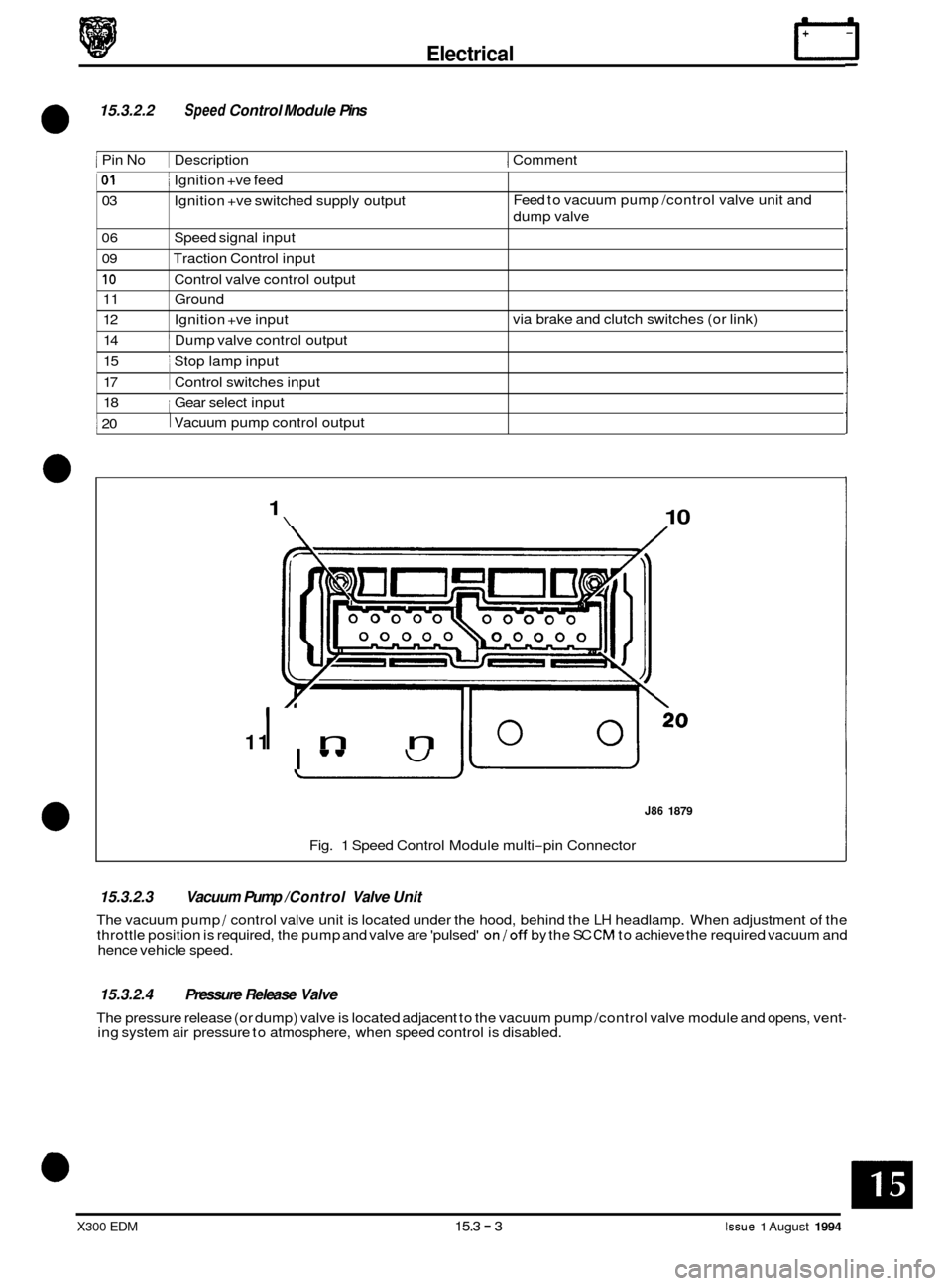
Electrical D ~
Ignition
+ve feed
Ignition +ve switched supply output I 01 03
06 Speed signal input
09 Traction Control input
10 Control valve control output
11 Ground
12 Ignition +ve input
14
15 ~
Stop
lamp input
17
1 Control switches input
18
j Gear select input
' Dump valve control output ~
20 I Vacuum
pump control output
15.3.2.2 Speed Control Module Pins
1 Pin No 1 Description I Comment
0
Feed to vacuum pump /control valve unit and
dump valve
via brake and clutch switches (or link)
0
0
1 10
A
11 'I n n 01 *O
I" " 1:
J86 1879
Fig. 1 Speed Control Module multi-pin Connector
15.3.2.3 Vacuum Pump /Control Valve Unit
The vacuum pump / control valve unit is located under the hood, behind the LH headlamp. When adjustment of the
throttle position is required, the pump and valve are 'pulsed' on/off by the SC CM to achieve the required vacuum and
hence vehicle speed.
15.3.2.4 Pressure Release Valve
The pressure release (or dump) valve is located adjacent to the vacuum pump /control valve module and opens, vent- ing system air pressure to atmosphere, when speed control is disabled.
X300 EDM 15.3 - 3 Issue 1 August 1994
Page 182 of 327
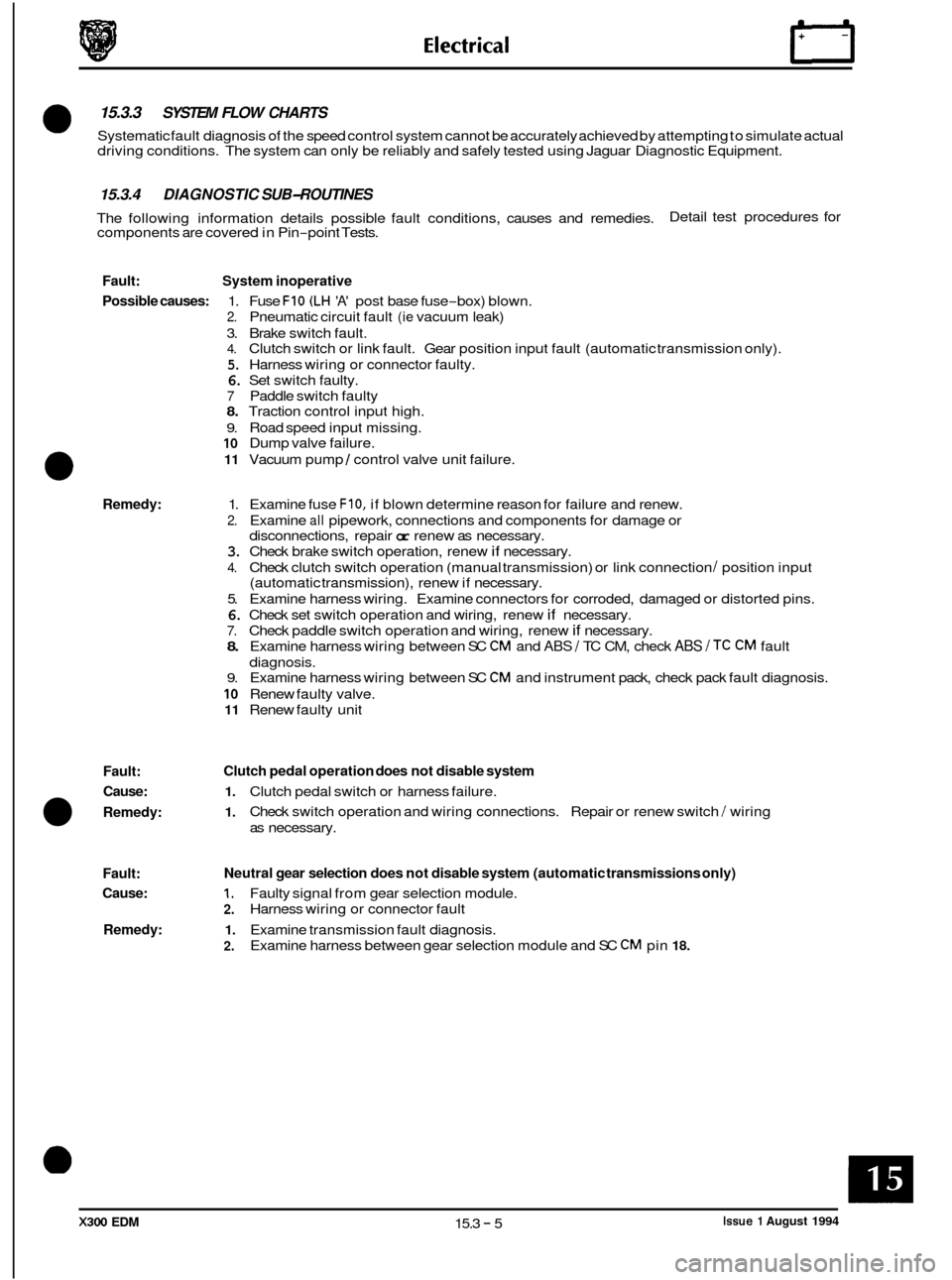
0 15.3.3 SYSTEM FLOW CHARTS
Systematic fault diagnosis of the speed control system cannot be accurately achieved by attempting to simulate actual
driving conditions. The system can only be reliably and safely tested using Jaguar Diagnostic Equipment.
15.3.4 DIAGNOSTIC SUB-ROUTINES
The following information details possible fault conditions, causes and remedies.
components are covered in Pin-point Tests. Detail test procedures
for
Fault: System inoperative
Possible causes:
1. Fuse FIO (LH 'A' post base fuse-box) blown.
2. Pneumatic circuit fault (ie vacuum leak)
3. Brake switch fault.
4. Clutch switch or link fault. Gear position input fault (automatic transmission only).
5. Harness wiring or connector faulty.
6. Set switch faulty.
7 Paddle switch faulty
8. Traction control input high.
9. Road speed input missing.
10 Dump valve failure.
11 Vacuum pump 1 control valve unit failure.
Remedy: 1. Examine fuse F10, if blown determine reason for failure and renew.
2. Examine all pipework, connections and components for damage or
disconnections, repair
or renew as necessary.
3. Check brake switch operation, renew if necessary.
4. Check clutch switch operation (manual transmission) or link connection I position input
(automatic transmission), renew if necessary.
5. Examine harness wiring. Examine connectors for corroded, damaged or distorted pins.
6. Check set switch operation and wiring, renew if necessary.
7. Check paddle switch operation and wiring, renew if necessary.
8. Examine harness wiring between SC CM and ABS / TC CM, check ABS /TC CM fault
diagnosis.
9. Examine harness wiring between SC CM and instrument pack, check pack fault diagnosis.
10 Renew faulty valve.
11 Renew faulty unit
0
Fault:
Cause:
1. Clutch pedal switch or harness failure.
Clutch pedal operation does not disable system
1. Remedy: Check switch operation and wiring connections. Repair or renew switch / wiring
as necessary.
Fault:
Cause:
1, Faulty signal from gear selection module.
Remedy: 1. Examine transmission fault diagnosis.
Neutral gear selection does not disable system (automatic transmissions only)
2.
2.
Harness wiring or connector fault
Examine harness between gear selection module and SC
CM pin 18.
X300 EDM 15.3 - 5 Issue 1 August 1994
Page 188 of 327
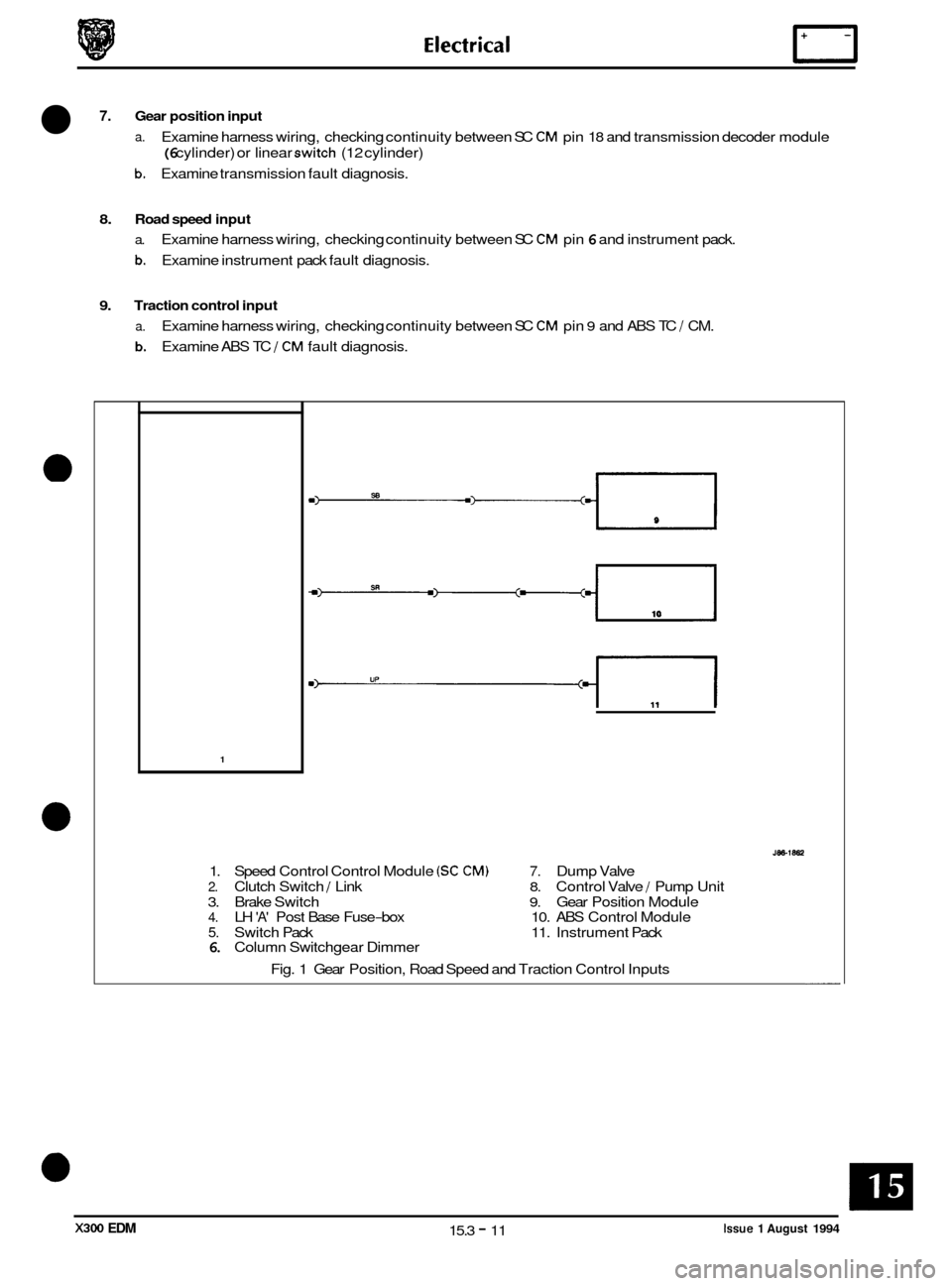
7. Gear position input
a. Examine harness wiring, checking continuity between SC CM pin 18 and transmission decoder module
(6 cylinder) or linear switch (12 cylinder)
b. Examine transmission fault diagnosis.
8. Road speed input
a. Examine harness wiring, checking continuity between SC CM pin 6 and instrument pack.
b. Examine instrument pack fault diagnosis.
9. Traction control input
a.
b.
Examine harness wiring, checking continuity between SC CM pin 9 and ABS TC J CM.
Examine ABS TC
J CM fault diagnosis.
1
1. Speed Control Control Module (SC CM) 7. Dump Valve
2. Clutch Switch J Link 8. Control Valve / Pump Unit
3. Brake Switch
9. Gear Position Module 4. LH 'A' Post Base Fuse-box 10. ABS Control Module
5. Switch Pack 11. Instrument Pack 6. Column Switchgear Dimmer
Fig. 1 Gear Position, Road Speed and Traction Control Inputs
Issue 1 August 1994 15.3 - 11 X300 EDM